China-Kyrgyzstan-Tajikistan in Melbourne Diaries
- Jan. 2, 2017, 5:23 a.m.
- |
- Public
This is the first of several travel entries from a Silk Road trip I took in late 2016 from Guangzhou to Dushanbe (in Tajikistan).
Notes on Guangzhou
I am staying in Guangzhou because it was simply too difficult to begin my trip from anywhere else. China Southern has a direct flight from Melbourne, but it doesn’t coordinate these flights with any domestic links. In the jumble of flight bookings, a transfer to Xi’an proved too cumbersome, involving midnight taxi runs, one night purgatories at airport hotels and assorted travel haggling in a language I don’t speak. So, based on the threadbare Silk Road justification that Guangzhou is where the maritime Silk Road began (as opposed to the land-based Silk Road starting at Xi’an), I’m here for three nights. A further difficulty is a late change of hotels, my centrally-based, lakeside hotel cancelling my booking a week ago, and having to be exchanged for the ‘Da Xin International Hotel’, which is close to Metro lines and the Baiyun mountains I’m planning to hike through, but still in the suburbs rather than near the places anyone would want to see. And, according to Google Translate, ‘Da Xin’ means ‘marsh’.
Not only am I in the wrong city in the wrong hotel, but I’m also here at the wrong time – cyclone season, that time of the year in Asia during which the air thickens into a thick, humid soup, watered down briefly every six hours or so by a thunderstorm. Everyone carries an umbrella and after each storm arrives, young men and women selling umbrellas seem to sprout from the footpath.
Typical Guangzhou apartment block next to hotel - first photo of trip. Shockingly, it’s raining.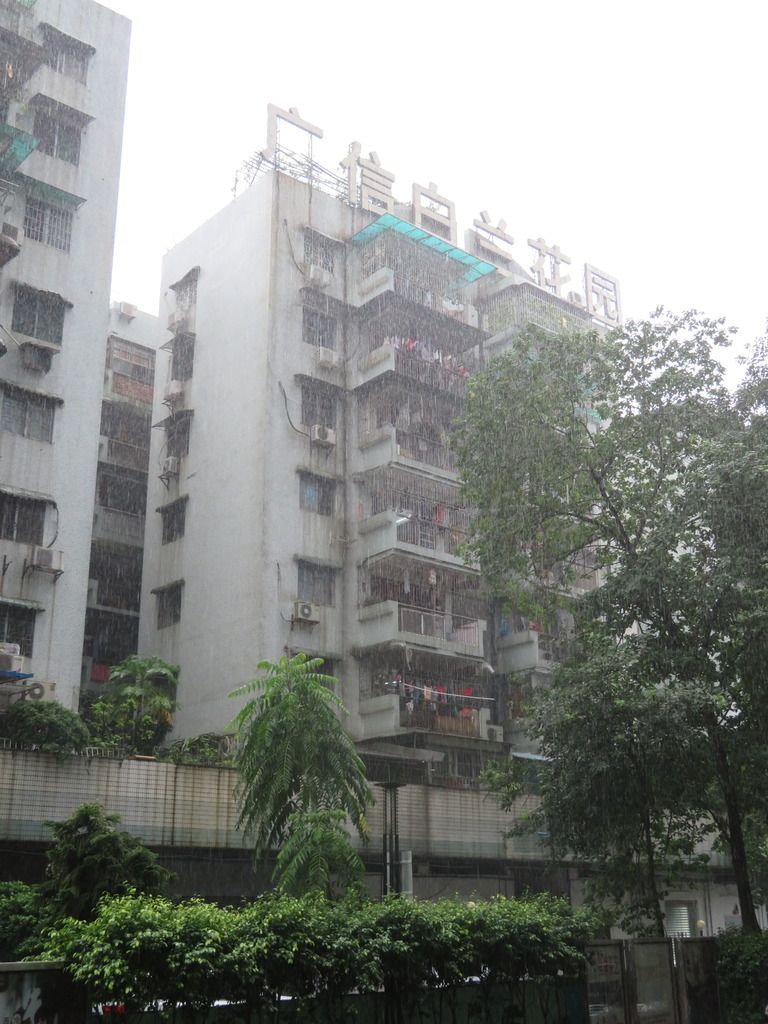
Guangzhou represents China in its economic boom phase: it has a modern metro system, multi-lane highways, apartment blocks sprouting like grubby concrete weeds (almost all balconies contain a mess of air conditions, pot plants and drying clothes, each of which is engaged in a Sisyphean struggle against Guangzhou’s weather), and even a gigantic lookout tower (that classic of civic penis envy). Guangzhou also has a reputation for boredom and cultureless corporatism, a multi-level tedium within nothing to see or do but vegetate in antiseptic business hotels with busy people heading off to corporate conferences. But in other ways it is atypical of Chinea – this is the Cantonese capital after all, and not a fully paid up member of mainstream Han China. The language is different, its Mandarin accents the subject of Beijing mockery, Cantonese food seems to have its own culinary marketing division (it is, the Da Xin’s dodgy Sino-Yankee dishes aside, truly delicious - their incredible street stall spring rolls are of a type I’ve never had before, which, on reflection, is something of a tragedy for me), and the sponge bath conditions will dissipate when I head inland.
The Da Xin International Hotel proves to be neither in a marsh nor international. It is located within a sprawl of shopping centres, two streets of competing market stores containing nothing but hair care products and a knot of traffic-churned roads. There are no tourist attractions in this area, so I suspect the hotel is a mid-range option for conference goers rather than wandering tourists. Like so much of China, its advertised (and, to be fair, very polite and attentive) ‘English-speaking staff’ don’t speak English at all and instead pretend to speak English through online translators, so that for much of my time there communication involves a conversation between their Samsung phones and my Google Nexus device (I am also reminded quickly about China’s international dispute with Google, as 90% of the Google-dependent applications on my phone fall dead at foot of China’s digital Great Wall). I am quickly trying to learn as much stammered traveller Mandarin as possible, but outside of basic greetings and Chinese numbers up to ten, the tonal nature of Mandarin defeats me. My translator lets you speak into the phone test out the foreign language phrases you do know, and I am shocked to find that in asking where the train station is I could be calling them a ‘bitch dog garden’. At least at the Da Xin International the linguistic incompetence is mutual. The ‘English menu’ at the near-empty hotel restaurant is a malapropristic delight, with half of the meals still unknown to me even after their translation – one is entitled ‘Three wire tommy spray’. Fortunately, there is an excellent bakery next to the hotel whose staff respond very well to the international sign language of pointing hopefully at things.
My first aim is to recover from the long plane trip by hiking up Mt Baiyun, a welcome splash of greenery and birdlife surrounded by concrete girdle a smog and bustle. The weather is Guangzhou’s usual alternation of steam cookery and lukewarm piss and, having arrived from a late Melbourne winter, I have saturated every layer of clothing by the time I get to the front entrance (my copious Westerner sweating is a great curiosity to the tighter-pored locals). Nevertheless, it is a pleasant hike through semi-tropical rainforests up to Moxing peak, where I am joined by some noisy Chinese army recruits who have jogged to the top (identical uniforms, shaved heads, shouting at each other the whole time). There is a statue to which couples have attached engraved lockets, some, sweetly, being in the shape of love hearts. A man from Shanghai engages me in conversation – like so many Chinese he is puzzled that I am heading inland. I am to discover that most coastal Chinese are unfamiliar with their own country’s innards (a trait they share with the residents of Australian coastal cities), and seem to view the interior as another country entirely. From the top of the mountain, the sprawl of Guangzhou is apparent. There is very little planning and even less artistry. While Canton tower, with its wicker broom shape, soars above the rainclouds, most of the buildings are of the large but cheap variety, falling somewhere between Soviet-era slumscapes and the type of Sydney skyscrapers rich Chinese people are investing in. They are emblematic of China’s construction growth, an obese consumption of concrete and steel. But they haven’t created a new New York or a Paris or even London. It’s all size and volume, big, dirty buildings housing wealthy yet classless people, a lifestyle for people with no style (and probably no life either). And all of it in a baking, cyclonic heat.
The next day I head into the centre of Guangzhou armed with a list of supposed must sees culled from a tatty printout of Guangzhou’s wikitravel page. The Chen Clan Academy, a 19th century hall, classes itself as one of Guangzhou’s most artistic sites, with intricate and attractive woodcarvings, pottery and statues (the most impressive for me being those that peer down at you, judgmentally perhaps, from the roof). There is also a folk art museum displaying kilned rubbish from the Cultural Revolution, the usual parade mandated smiling Chinese heroes showing all the hooked-nosed American pigdogs who’s boss. Tasteless and devoid of talent, they are intruders in the older, reverential Academy house, or in any museum for that matter. I visit several other historic sites, including the Sun Yat-Sen Memorial Hall, the Father of the Chinese Nation not being too well served by the bland octagonal concert hall and the small and parochial display of his life inside the building (though I love the gardens, with their gigantic kapok trees, the limbs of which drip onto the pathways). The Guangxiao Temple is the most religious of the wikitravel-guided location, and I am drawn to a monk who, in the grey wet heat of the afternoon, slowly edges himself forward on his knees in prayer, proving his devotion one slow, excruciating inch at a time, oblivious to the locals holding umbrellas and shopping bags.
Prostrate monk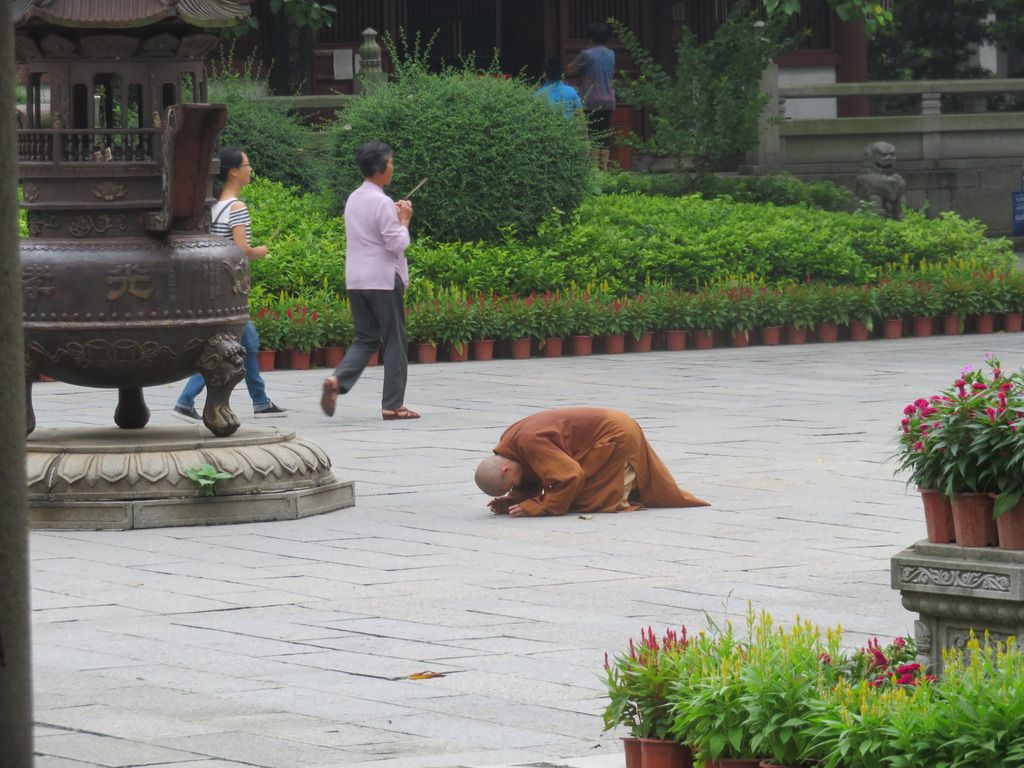
Chen Chan Academy wall art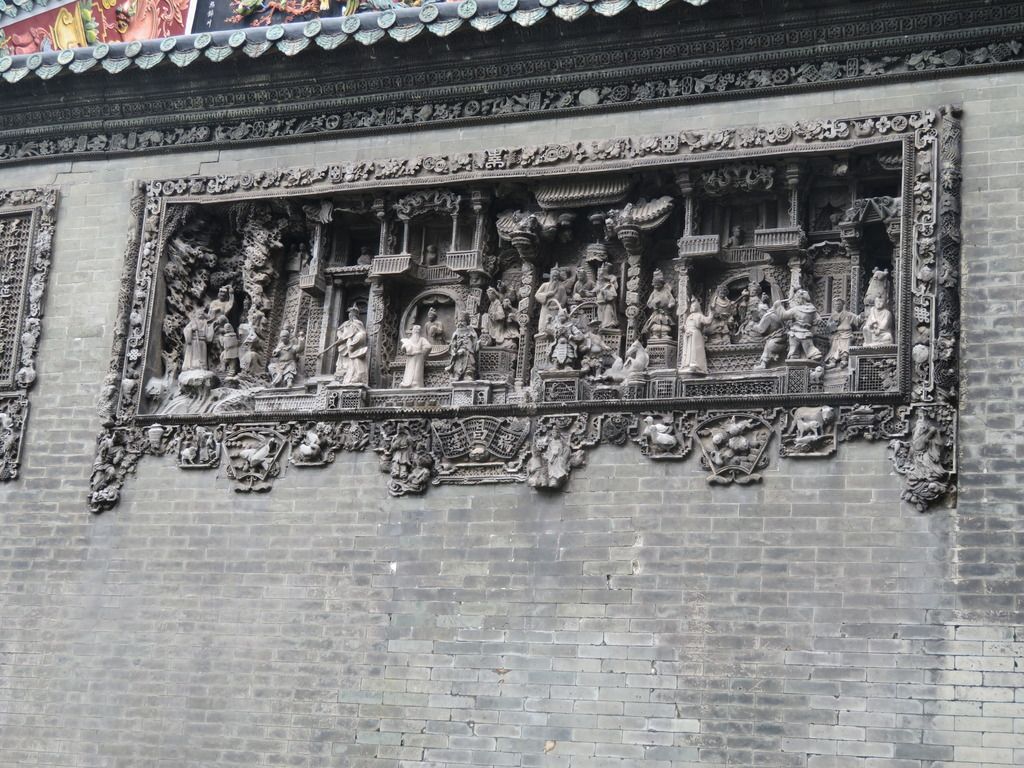
I also try the obligatory tourist trip up to the top of Canton Tower, which, at 600m metres tall, was once the tallest tower in the world – at least until, one year later, the Tokyo tower pipped it by 34 metres. There’s a thick white cloud at ground level today, ensuring that nobody is seeing anything, but that doesn’t stop two women in the lift I’m in from announcing their claustrophobia by shrieking in terror the whole three minutes up. At the top of the tower I pay my Yuan to travel five minutes in a golf-buggy sized carriage on rails that circles the observation deck. From this 600m vantage point I observe absolutely nothing except more rain and even thicker grey-white clouds. At the base of the tower are numerous tea houses and souvenir stalls, one of which sells ‘Orange Pu-erh tea’, which, given that the Da Xin’s only alcohol comprises Budweiser beer (meaning that the hotel managers are either teetotallers or entirely lack taste buds) is sure to become my staple beverage. Pu-erh tea, a dark, fermented brew, is one my favourite teas, and as soon as the Chinese realise how unpleasant its name sounds to English speakers and instead apply some superfood neologism to it, the stuff will be a sensation overseas.
Canton tower
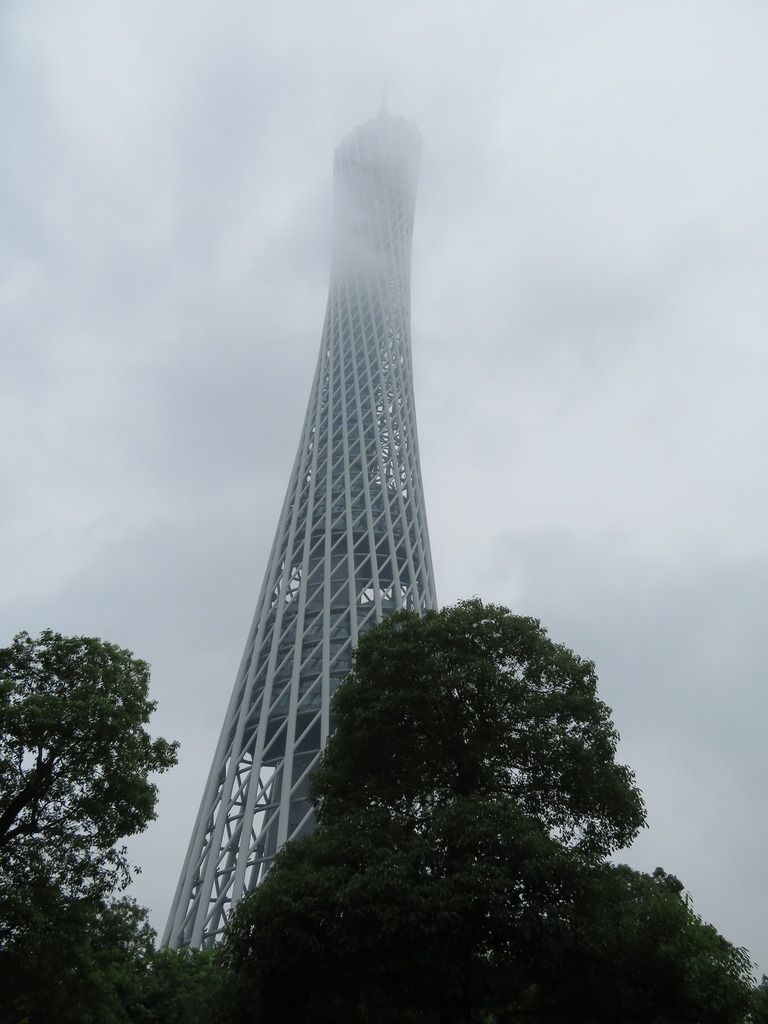
In the metro station near the tower are three young men lugging guitars and looking awkward. One approaches me and with an American accent (with streaks of Canadian) asks what I’m doing in Guangzhou. The three men are a blues band from Michigan who have been making a living for the last few months playing every night at a nearby bar in the Guangzhou commercial district for Chinese conference delegates and their mistresses. I ask if there’s much call for blues music in this city.
“No… not really”, one of them replies. He’s lightly bearded and the presumptive leader of the trio. “It’s all Chinese pop music here. Nothing else. We don’t get large audiences”. There is a sad pause, indicating a total absence of on-tour applause, money or sex.
“Do you do other types of music?” I ask.
“Some country, bluegrass… that sort of thing.” Another pause. He’s chewing gum, which only enhances his aimlessness. “Do you like music?” he asks, far too hopefully. “You should come to our gig tonight?” Sadly, the venue is too far away from my hotel for me to sympathetically attend.
The next day Guangzhou decides it’s being going easy on me weather-wise and really lets loose with one downpour after the other. I spend most of the day at Yuexie park, scuttling crab-like from the rain from one wooden tourist shelter to the other. The Five Rams statute is a popular drawcard, and I stock up on my Communist party-themed fridge magnet, all of which will later be confiscated at Guangzhou airport by an overly officious woman with a Communist party badge. The information plaque for the statute may as well come from Journey to the West (or a serotonin-destroying dosage of DMT):
“The Five-Ram Sculpture is one of the most famous structures in Guangzhou. It has become the emblem of the city. Legend has it that more than 2,000 years ago, the city was a barren land with people who despite hard work were suffering from famine. One day five immortals in five-colour garments came riding on five rams, playing their legendary music. The rams held sheaves of rice in their mouths. The immortals left the sheaves of rice for the local people, gave blessings to the city and left. The rams turned into stone and the city became a rich and populous place. Guangzhou got the name of the City of Rams and the City of Ears.”
I think the statue itself was built in 1989. But then, it’s no less silly than Rome’s foundation story and that city didn’t do too badly. Much of Guangzhou’s temples, sculptures, churches were smashed apart by the Communists during the Cultural Revolution. With few real monuments to visit, and the truth of Guangzhou’s history lying somewhere beneath the mud and bullshit, tourists instead buy Communist tattery next to stories about rams with rice sheathes in their mouths.
The fourteenth century Ming dynasty Zhenhai (Sea Guardian) tower (destroyed and rebuilt five times over) turns out to be my symbolic Silk Road starting point, as it contains exhibits from the ancient trade route, including beautiful 12th century carvings of Sogdian traders with flat, Caucasian faces, and artefacts stolen all the way from Kyrgyzstan. The museum is impressive, as are the turtle-eyed red lions flanking the entrance, beautiful Ming survivors of centuries of cultural vandalism - pretty much every new cultural vanguard decided to busy itself in Canton by smashing up the Zhenhai tower..
At the train station next to the park, a young woman in an end-of-my-shift excitement waves a rain-soaked leaflet at me, saying twice in halting English: “You. Buy house. Guangzhou!” The leaflet is for some new exclusive high level residential accommodation being built nearby. Is there anyone in the world who would make a lifetime property investment on the word of a shouty pamphleteer outside a train station? The eagerness of this woman to sell a mega-apartment to a sodden Westerner in a ratty-looking A-League football jersey (go Melbourne Victory!) suggests that China’s property boom, while at its strongest in Guangzhou, is also reaching peak ridiculousness, one pricing correction away from it’s predicted financial crisis. And then who will come here?
In this trip, Guangzhou will for me be China at its richest and dullest, a bulging megacity, all growth and profit and bluster. While by no means the centrepiece of Xi Jinping’s Chinese dream (its Cantonese origins and separate language make it too suspect for that), Guangzhou, the city blessed by ram-riding, rice-baring immortals, is for better or worse, so much of what China seems to want to be. With a lot of rain.
Lockets at the top of Mt Baiyun
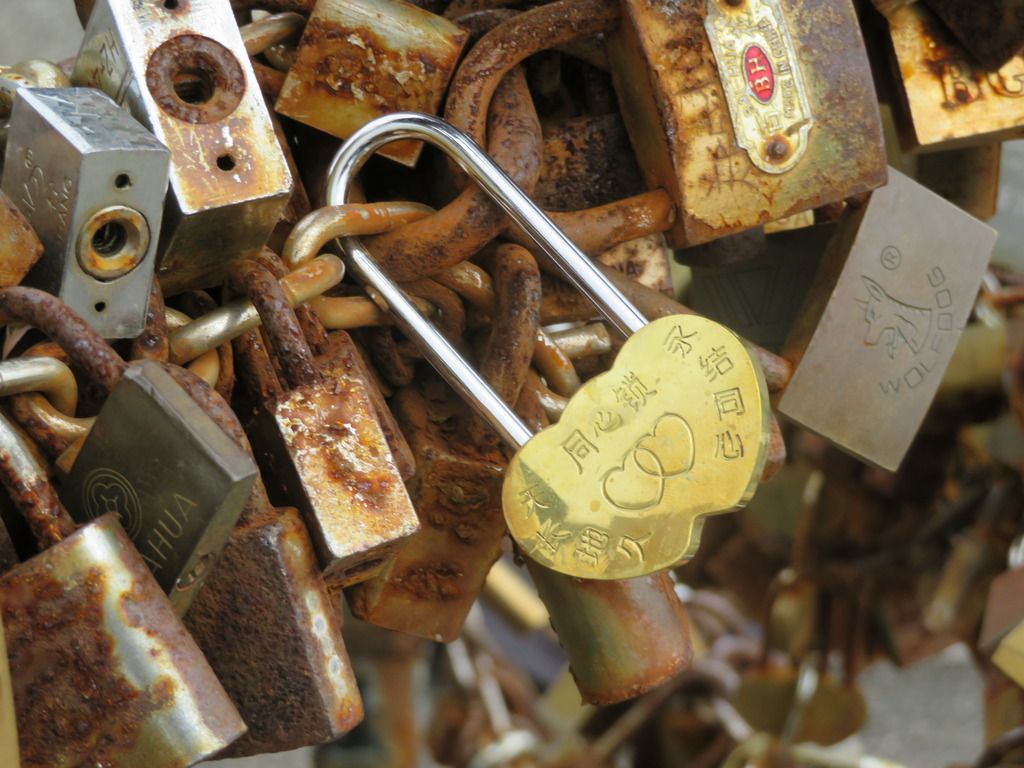
Kapok tree, Sun Yat Sen memorial
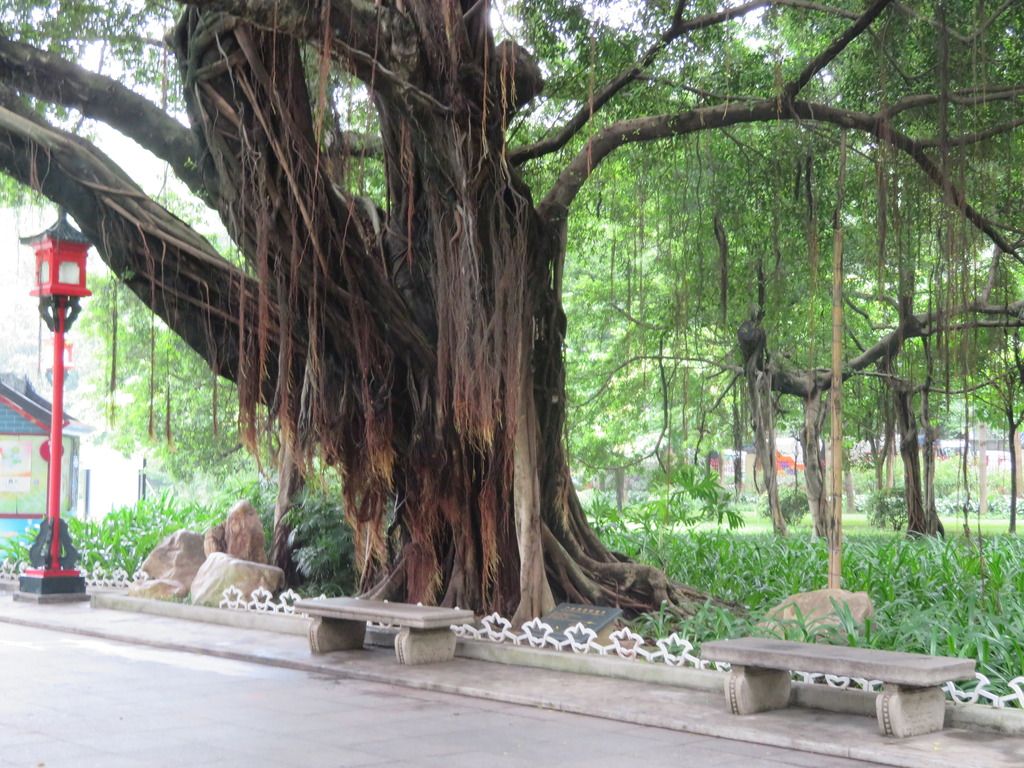
Five Rams (and more rain)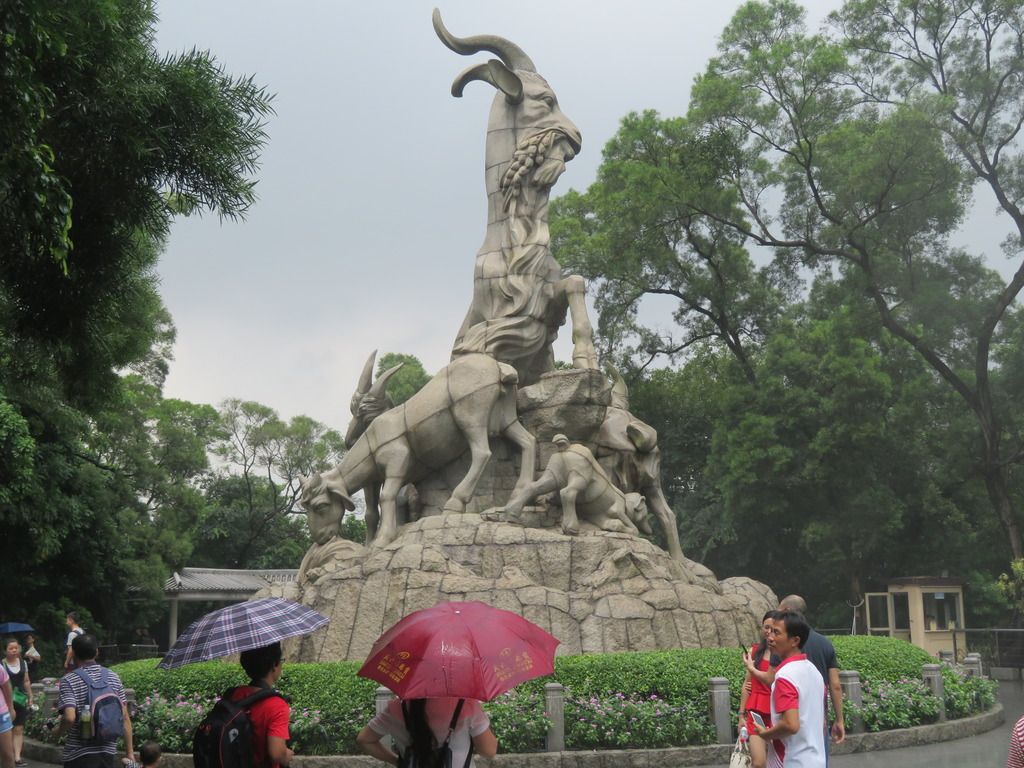
Old city walls, still raining
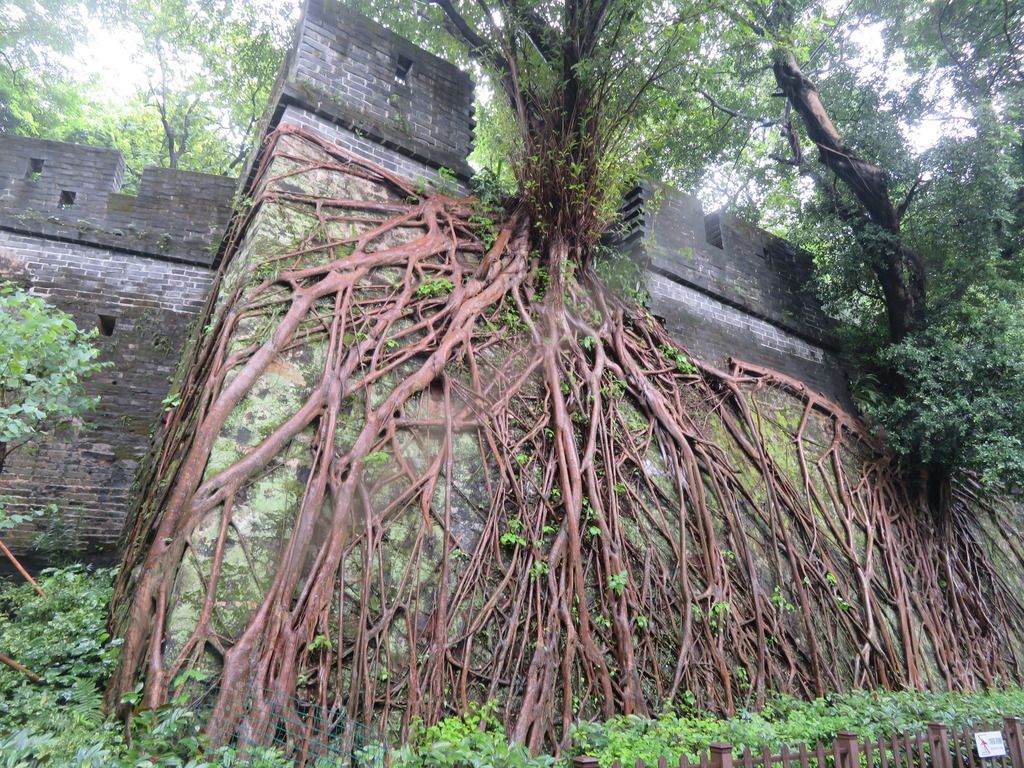
Last updated January 10, 2017



Loading comments...